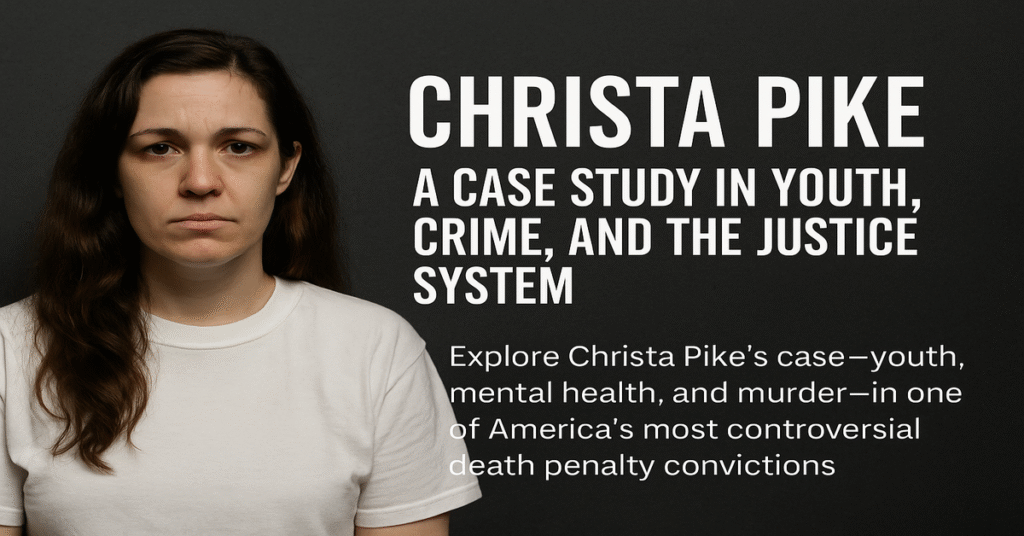Christa Pike case is one of the most chilling and controversial in the history of American criminal justice. Convicted of murder at the age of 18, Pike became the youngest woman sentenced to death in the United States in the modern era. Her story has sparked debates around mental health, juvenile crime, the death penalty, and the influence of environment on criminal behavior.
This article explores the life of Christa Pike, the events leading up to the murder for which she was convicted, her trial, psychological profile, and the broader legal and social implications of her case. It also delves into the consequences of youth violence and the complexities of dealing with juvenile offenders in the justice system.
Early Life and Background
Childhood and Family Environment
Christa Gail Pike was born on March 10, 1976, in West Virginia. Her upbringing was troubled from an early age. Reports indicate that Pike endured a chaotic childhood, marked by instability, neglect, and exposure to substance abuse.
She lived with her mother, Carissa Pike, who reportedly struggled with her own issues and had difficulty providing a stable environment. Christa’s father was largely absent from her life, and by most accounts, she lacked consistent parental guidance or support. This created a vulnerable foundation that would later contribute to her mental and emotional instability.
Behavioral and Psychological Issues
From adolescence, Pike exhibited signs of emotional and behavioral disorders. She struggled with authority figures, displayed erratic moods, and was involved in various disciplinary problems in school. Pike also had a history of self-harm and reportedly exhibited signs of obsessive behavior.
Several mental health evaluations conducted later in her life would diagnose her with borderline personality disorder, among other possible conditions, though her mental state would become a point of contention during her trial and appeals.
Enrollment in Job Corps Program
A Fresh Start
In an attempt to improve her future, Pike enrolled in the Job Corps program in Knoxville, Tennessee. The Job Corps is a federal program aimed at helping young adults gain job training and education to become self-sufficient.
There, she met individuals who would become central to the events that unfolded in 1995, including Tadaryl Shipp, her boyfriend, and Colleen Slemmer, her eventual victim. This phase of her life, intended to bring stability and opportunity, instead became the backdrop for a horrific crime.
The Crime: Murder of Colleen Slemmer
Tensions and Jealousy
Pike grew increasingly jealous and paranoid that Colleen Slemmer, a fellow Job Corps student, was attempting to interfere with her relationship with Shipp. Reports suggest that Pike believed Slemmer was flirting with or trying to seduce Shipp, although there was no concrete evidence of this.
Pike’s growing obsession, coupled with her unstable mental state, led to a deadly plan. On January 12, 1995, she lured Slemmer under the pretense of making peace, along with Shipp and another student, Shadolla Peterson.
The Brutal Attack
They took Slemmer to a secluded area near the University of Tennessee Agricultural Campus. What followed was a prolonged and brutal assault. Slemmer was tortured for approximately 30 minutes before Pike delivered the fatal blow with a chunk of asphalt. The attack included physical and psychological torture, including carving a pentagram into Slemmer’s chest.
After the murder, Pike kept a piece of Slemmer’s skull as a trophy, a detail that shocked the public and contributed to the portrayal of her as a remorseless killer.
Arrest and Confession
Swift Apprehension
The police investigation quickly led to Pike and her accomplices. The evidence was overwhelming. Not only did Pike boast about the crime to fellow students, but she also kept the incriminating skull fragment and wrote detailed notes about the incident.
When confronted, Pike confessed to the murder without much hesitation. Her confession, along with physical evidence and witness testimony, solidified the prosecution’s case.
Trial and Sentencing
Court Proceedings
During the trial, Pike’s defense attempted to portray her as a disturbed teenager who had suffered years of emotional trauma and neglect. They argued that her mental health issues and lack of proper support contributed to her actions.
However, the jury found the brutal nature of the crime too egregious to overlook. The prosecution emphasized the premeditation, the sadism involved, and Pike’s lack of remorse.
Sentenced to Death
In March 1996, Christa Pike was convicted of first-degree murder and conspiracy to commit murder. She was sentenced to death, making her the youngest woman in the United States to receive the death penalty since its reinstatement in 1976.
Psychological Profile
Expert Evaluations
Psychologists who evaluated Pike described her as suffering from serious mental illness. Diagnoses included borderline personality disorder, antisocial traits, and possible psychotic features.
Despite these findings, the court deemed her competent to stand trial and responsible for her actions. The balance between mental illness and legal culpability became a central theme in her appeals.
Life on Death Row
Incarceration at Tennessee Prison for Women
Pike was sent to the Tennessee Prison for Women in Nashville, where she has remained on death row since her conviction. Her time in prison has been marked by additional incidents, including a 2001 attempt to kill a fellow inmate.
This incident further reinforced concerns about her mental state and dangerousness, though it also fueled arguments for reevaluating her sentence due to ongoing psychological instability.
Appeals and Legal Proceedings
Post-Conviction Appeals
Pike’s legal team has filed multiple appeals over the years, arguing that her trial was flawed due to ineffective counsel, improper handling of mental health evidence, and the failure to consider mitigating factors adequately.
Despite several attempts, courts have consistently upheld her conviction and death sentence. In 2012, the Tennessee Supreme Court denied her latest appeal.
Requests for Clemency
Human rights organizations and mental health advocates have petitioned for clemency, citing her age at the time of the crime, her documented mental illness, and the unusual severity of her sentence compared to other juvenile offenders.
However, no governor or parole board has yet intervened to commute her sentence.
Controversies and Public Reaction
Media Coverage
Christa Pike’s case received widespread media attention, largely because of the gruesome nature of the crime and her young age. News outlets portrayed her as a symbol of teen violence, often using her case to highlight the risks of untreated mental illness and societal neglect.
Public Debate
Her case continues to divide public opinion. Some argue that Pike is a monster who deserves the harshest punishment, while others believe she is a tragic product of a broken system that failed to address her needs long before the crime occurred.
Broader Implications
Juvenile Offenders and the Death Penalty
The Pike case reignited national conversations about whether minors should be eligible for capital punishment. While the U.S. Supreme Court later ruled in Roper v. Simmons (2005) that individuals under 18 cannot be executed, Pike was already 18 at the time of her crime.
Nonetheless, her case is frequently cited in discussions around youth sentencing, rehabilitation versus retribution, and how the justice system treats mentally ill defendants.
Mental Health in the Legal System
The intersection of mental illness and criminal justice is a recurring theme in the Pike case. It raises difficult questions: How do courts assess responsibility in individuals with severe mental illness? Can punitive justice coexist with compassion for psychological suffering?
Pike’s situation illustrates the challenges faced by the justice system in balancing these competing demands.
Current Status and Outlook
Awaiting Execution
As of the latest public information, Christa Pike remains on death row. Her execution has not been scheduled, but she remains eligible under Tennessee law unless future clemency or legal decisions alter her fate.
Potential for Commutation
While clemency is unlikely without significant political or public pressure, shifting views on the death penalty and increasing awareness of mental health issues may influence future decisions regarding Pike and others like her.
Conclusion
The case of Christa Pike is a deeply unsettling chapter in American criminal history. It represents the convergence of youth, violence, mental illness, and justice in a way that defies easy explanation or resolution. Whether viewed as a cautionary tale, a judicial tragedy, or a symbol of societal failure, Pike’s story continues to provoke discussion.
As debates around the death penalty, juvenile justice, and mental health evolve, the lessons from her case remain profoundly relevant. Understanding her life and actions requires not just legal judgment but also a broader societal reflection on how we prevent such tragedies from recurring.
FAQs
1. Who is Christa Pike?
Christa Pike is an American woman convicted of the 1995 torture and murder of Colleen Slemmer. She was sentenced to death at age 20.
2. Why did Christa Pike kill Colleen Slemmer?
Pike was reportedly jealous and paranoid that Slemmer was pursuing her boyfriend. She planned and carried out a brutal murder driven by obsession and instability.
3. Is Christa Pike still on death row?
Yes, as of the latest updates, Christa Pike remains on death row at the Tennessee Prison for Women in Nashville.
4. What mental health issues does Christa Pike have?
Pike has been diagnosed with borderline personality disorder and other psychiatric conditions, which were considered during her trial and appeals.
5. Can Christa Pike be executed?
Yes, she is eligible for execution under current Tennessee law, although her execution has not been scheduled.
6. Why is Christa Pike’s case controversial?
Her case is controversial due to her age at the time of the crime, the extreme violence involved, and ongoing concerns about mental illness and the use of the death penalty.







